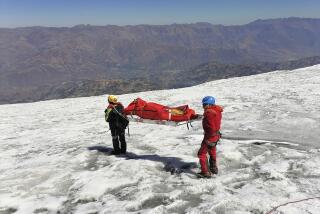Trekking to Cloud 9 in Nepal
Maybe it’s the exalted beauty of the mountains or the golden glow of the sunsets, maybe oxygen deprivation. Maybe it’s the twinkling eyes of the rugged men who work as guides in the Himalayas. Or maybe it’s the way trekking in Nepal, a little country perched between China and India, makes Western women yearn for transformation of both body and soul.
Along with fluttering Buddhist prayer flags and eight of the world’s 10 highest mountains, love and sex are in the air for Sherpas and female trekkers in this kingdom in the clouds.
“A lot of single American women go to Nepal looking for romance. It’s been going on forever,” says Richard Bangs, a founder of the adventure travel company Mountain Travel Sobek in El Cerrito, Calif.
Barbara Pijan of Portland, Ore., met mountain guide Gyeljen Lama on a trek to Mt. Everest base camp in 1986. “I was working on my dissertation in divinity at the University of Chicago, and he was a yak herder with a fourth-grade education,” she says. “But on the way down, I got this incredible rush of oxygen. I was in an ecstatic state just breathing, and our plane was delayed for three days. So I said, ‘Oh, who cares?’ and got involved with him.” She is now Barbara Pijan Lama; they have been married 11 years.
It’s hard to say who, if anyone, gets exploited when two cultures commingle so intimately. Still, many women return home from Nepal with spicy flings to tell their friends about and little thought of the consequences of their dalliances. Others fall in love with Sherpas and must walk difficult paths to make extreme cross-cultural romances work.
The Nepal Tourism Board doesn’t tout the country’s aphrodisiac qualities, and it would be an overstatement to say that the Himalayan kingdom has become a Third World fleshpot. Still, some years ago, the U.S. Embassy in Katmandu distributed a brochure to American trekkers “to provide perspective and relay experiences of men and women who had assisted their porters in visits to the U.S,” said embassy spokesman Robert C. Kerr. Some jokingly referred to the brochure as “So, You Want to Take Your Sherpa Home?”
The former Donna Marie Larson, a high school history teacher from Newark, Del., likes to say she brought home a big souvenir from a 1988 trek in Nepal: her husband, Phurba. She is now Donna M. Sherpa. At the time of her trek, she was a retiring woman of 39 who surprised herself by pursuing the shy 24-year-old Sherpa. She realized that she had to take the initiative because consorting with a client could reflect badly on a Sherpa, and she said to herself, “ ‘If he laughs and rebuffs me, I’ll just walk away.’
“I tried to give him lots of signals,” she says. Later, Phurba said, “I thought about approaching you, but what if you screamed?”
Sherpas are a small ethnic group in Nepal--about 110,000 out of a population of 23 million, according to the Royal Nepalese Consulate General in New York. They migrated from Tibet to the remote region around Everest about 500 years ago. Because they don’t use surnames, they usually take such designations as “Sherpa” or “Lama” as last names when applying for passports and visas. They are Buddhists in a Hindu country and have been famous for their mountaineering skills since Sherpa Tenzing Norgay and Sir Edmund Hillary in 1953 became the first to reach the top of Everest.
For the last 10 years, Sherpas have played a major role in the vacation trekking business, though other Nepalese have entered the field and the word “Sherpa” has come to mean anyone who works as a trail guide.
Although tension stemming from the June 1 palace slayings of Nepal’s royal family is expected to dampen tourism, the country is visited by about 500,000 tourists a year. About a quarter go on mountain treks. The influx of outsiders has had a Westernizing effect on the culture. Fudge brownies, T-shirts, hotel rooms with private baths and Internet cafes can be found readily in Katmandu, the capital.
Tourists who have affairs with Sherpas have introduced something else to the culture. “Sex in Nepal used to be more functional, tied up with reproduction and family obligations. Western culture has introduced the idea that you can have sex for the sake of sex,” says Vincanne Adams, author of “Tigers of the Snow and Other Virtual Sherpas: An Ethnography of Himalayan Encounters.”
Before the tourism boom, Sherpas were universally described as shy. “But what are you going to do when a woman climbs into your sleeping bag?” says Brot Coburn, an author and special projects director for the American Himalayan Foundation in San Francisco.
The ways of love are mysterious, in Portland or Katmandu. Still, some Western women are drawn to Sherpas for a predictable set of reasons.
Sherpas, by ethnicity or occupation, are “strong, handsome men, generous and warm. They seem to have all the values our culture lacks,” says Michael Covington, a Colorado climber who scaled Nepal’s peaks in the late 1970s.
“They seem very open. You see their feminine side,” says Antonia Neubauer, founder of Myths and Mountains, a Nevada tour company that specializes in trips to Nepal.
On the trail, the Sherpa’s job--a prestigious and lucrative one--is to help clients reach breathtaking heights and to make them comfortable and happy. “They really serve you. They even bring tea to your tent in the morning. This kind of treatment can be very attractive to women who are fed up with the Western dating scene,” Neubauer says.
It’s a female variation of the Peter Pan syndrome, she says. “Somebody sprinkles gold dust on Wendy, takes her by the hand and helps her do the hardest, most extraordinary thing she’s ever done in her life. She sees all the little lost boys and wants to get involved in their culture,” Neubauer says.
Marilyn Mason, a Santa Fe, N.M., psychologist who’s been on trekking trips in Nepal, Tibet, Peru and Tanzania, says such liaisons are not uncommon when American women travel to exotic places. She’s seen long-married women with children on the verge of giving it all up for attentive local guides. “They forget that they’re paying for the attention,” Mason says.
Pijan Lama, 45, one of the few American women with a long-term marriage to a Sherpa, says she’s seen relationships between Sherpas in their 20s and Western women twice their age.
Many of the women are lonely professionals who put off marriage to pursue careers, she says, and find out too late that there are few available men left in their socioeconomic group.
For a Sherpa, the attractions of romance with a Western woman are a little more complicated. Nepal is an impoverished country, where youngsters leave school to work in high mountain fields or in meadows tending yaks. The ticket to a better life is schooling in English or computer science. That can cost $750 a year, an astronomical sum for a Nepalese, but not, it would seem, for a Western woman who may have paid many times that amount for a trekking vacation.
“All of the Sherpas I’ve met are looking for an angel,” especially one who would give them a chance to work in the U.S., says Joyce Tapper of Van Nuys, a Nepal-lover who takes trekking trips there as often as she can. “Just one season in a restaurant or picking crops here, paying no taxes, and a Nepalese guy can go home with $3,000 in the pocket of his new Levi’s 501s,” says Tapper, who admits that the first time she trekked (with her husband), “I could easily have fallen for our guide.”
But hearts have been broken and lives derailed when East meets West on the footpaths of the Himalayas. Some of the Sherpas who get friendly with trekkers have wives and children back home. This poses serious problems if couples try to turn trail romances into long-term relationships, leaving Nepalese women alone in remote villages knitting sweaters for export, weeding potato patches and waiting for support checks.
Danu Sherpa has been married five years to Sandra Jacobs, a nurse anesthetist he met on a trek in 1996. Danu, who works for the city park service in Redmond, Wash., tells a kind of cautionary tale about his brother, Dawa. Several years ago, Dawa left his wife and two children for a Japanese American woman with whom he set up housekeeping in a large Katmandu apartment he could ill afford. “She didn’t have a job. He paid all the rent and spent all his savings,” Danu says. The woman stayed for six months, then left for Australia, where she met someone else and sent Dawa a “Dear John” letter. “He was very depressed. She had promised to take care of his children,” says Danu. In 1998, Dawa committed suicide.
According to Coburn of the American Himalayan Foundation in San Francisco, some trek leaders on Everest tell their porters and guides that sex with Western clients defiles the great mountain, leading to disasters such as the deaths of eight climbers on Everest in spring 1996.
But some Sherpas see pleasuring clients as a part of the job; others have adopted a macho attitude about sex on the trail, viewing it as a perk and becoming more “Don Juanish,” says anthropologist Sherry B. Ortner, author of “Life and Death on Mt. Everest: Sherpas and Himalayan Mountaineering.”
And homosexuality, which once existed only in an intensely covert way, has all but come out of the closet in Nepal, with male trekkers from the West, like female trekkers, finding Sherpa romances.
Though Coburn says he doesn’t believe that Sherpas have changed that much, some Westerners say that the guides aren’t the beguilingly shy spirits they once were and that women who blithely play around in Nepal have to answer for that.
“I think that women who are entering into one-night stands with Nepalese men are breaking existing Nepalese conventions,” says Ruth Rosselson, a freelance writer in England who has trekked in the Himalayas. “They’re also reinforcing a distorted view of the ‘sexually liberated’ West and making things harder for women who visit after them. Sexual harassment may be more prevalent in the future because of this.”
The U.S. Embassy in Katmandu rarely gets reports about sexual harassment of female trekkers. Still, Alicia Dunams, a young American who trekked the popular Annapurna region on her own several years ago, says Nepalese porter-guides hounded her to take them along. “I didn’t want to go with a Sherpa,” she says, “because I’d heard you could get raped.” Other women report subtler advances, Sherpas who sweetly ask if they’re lonely in their tents.
Pradeep Raj Pandey, chief executive officer of the Nepal Tourism Board, worries about the increasingly aggressive behavior of some Sherpas. “What I’ve seen and don’t like is soliciting. I don’t want anyone to get trapped into something they don’t want to get into.”
Western women who stay in Nepal with Sherpa lovers sometimes do feel trapped. Work opportunities are limited. The society is paternalistic; men drink, spit, play cards with friends and then disappear for months on treks. “Western women don’t understand that domestic abuse and alcoholism” can happen in Nepal just as in the U.S., Pijan Lama says.
Wendy Brewer Lama, who met her husband on a trek in 1986 and lived in Katmandu with him for three years before getting married, couldn’t jog without being stared at. Still, she willingly took up the role of spouse, which includes social obligations in Nepal. She was lucky, because her husband’s family welcomed her, unlike others who cut their sons off when they take up with Westerners. “Some mixed couples stay separate,” she says. “But as an outsider in another culture, I really wanted to be accepted.”
Sherpas want to come to the U.S. because they’ve heard that “this is the place where they can make it,” says Tsewang Sherpa Lama, a founder of the United Sherpa Assn. in New York. He estimates that there are about 2,000 ethnic Sherpas in the U.S. Anecdotal reports indicate that as many as 500 could be in mixed marriages or relationships.
But many soon learn that America is not the golden mountain they expected. With poor English language skills and scant education, many face insurmountable problems finding good jobs. Suddenly, the tough, capable men of the Himalayas find themselves as dependent on their women as the women were once on them.
“It was very stressful,” Pijan Lama says. She estimates that only 10 of the 50 or so mixed marriages she’s seen in the U.S. have survived.
A healthy sense of humor and her conversion to Buddhism have helped keep her marriage alive. Her husband, Gyeljen, who cut wood for a time, found a job at a recycling plant. And the couple have a 7-year-old son, Daniel Mingmar.
When Donna and Phurba Sherpa settled in the U.S. a decade ago, Donna hired an English tutor for Phurba and discovered that he was good at math. For a while he worked at a lumber mill, then learned cabinetmaking, which has given him confidence and a sense of self-worth. Donna gleefully calls him a “manual man,” who gets along with everybody and never stops working, though she says she is the dominant one in the relationship. “I pay the bills and make the plans,” she says. “He lives every day in the moment and can’t think about the future.”
Adventure travel expert Bangs believes that sexual relations between trekkers and Sherpas are mutual in most cases and not unique to Nepal. “There’s nothing particularly destructive about it,” he says. “Culture is an evolving thing. People on all sides are trying to better their lot.”
Myths and Mountains’ Neubauer sees it a little differently. Such affairs stem from “the honest effort of people to make a bridge between the two worlds,” she says. “They think they’re talking the same language, but they’re not.”
More to Read
Sign up for The Wild
We’ll help you find the best places to hike, bike and run, as well as the perfect silent spots for meditation and yoga.
You may occasionally receive promotional content from the Los Angeles Times.






